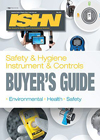But slips, trips and falls are a serious concern in the workplace. In fact, they are one of the top causes of injuries in today’s workplaces. Slips, trips and falls account for thousands of employee injuries each year, including some that are disabling and even fatal. About 20 percent of all workplace injuries are caused by slips, trips and falls. For the employer, recordable slips and falls result in an average of 11 days away from work and a sizable cost of $40,000 per incident.
In May 2010, OSHA announced that it plans to tighten the standards on walking-working surfaces, which will be designed to help protect against slips, trips and falls in the workplace. The changes would allow OSHA to fine employers if they do not meet the additional stipulations on fall protection and safety.
What can your company do to prevent slips, trips and falls from occurring in your workplace?
Steps to prevention
1. Assess your slips, trips and
falls needs.
Ask an authorized employee or a third party to come on site and perform a complete audit of your facility. Oftentimes you’ll find that there are more hazards than you realized. During the assessment, ask the employee or third party to document and summarize both the required and recommended steps that your facility should take to minimize your risk of slips, trips and falls.
2. Mark your aisles, passageways and uneven surfaces.
Use heavy-duty, highly visible warning tape and floor tape to mark any uneven walkway and floor surfaces in your facility. If the walkways are exposed to a variety of lighting conditions, use reflective or photoluminescent warning tape to ensure that they will be seen at all times.
3. Provide traction on slippery surfaces and stairs.
Stairs are one of the most common areas in a workplace for slips, trips and falls. To prevent injuries, make sure your stairs are marked with anti-skid floor tape that withstands grease and oil. For added protection, install anti-skid tape with yellow and black stripes and text that reads “Caution” or “Watch Your Step.”
4. Place safety signs, devices and labels to warn of hazards.
Use a variety of warning devices to notify employees of a hazard before they approach the area. Have a third party conduct a facility signage walkthrough to help you identify the areas of your facility that need signage and warning devices. These devices can include safety cones, floor signs, floor stands, safety and caution signs, tape and more. Remember that the best place for a warning device may not be directly on a hazard. It could be above, below or to the side of the hazard; place it wherever it will be most visible to employees before their final approach to the hazard.
5. Maintain proper housekeeping.
Be sure to keep your work environment and walking areas free of obstacles, including trip hazards like cables and wires. Many companies even mark walkways and work areas with yellow lines and enforce policies for “obstruction-free zones.”
6. Mark temporary maintenance and janitorial hazards.
Proactively identify situations that may cause slips, trips and falls, and be sure to mark the areas ahead of time. Short-term hazards due to maintenance and housekeeping should be marked with cautionary floor stands, barricade tape and warning posts and chains.
7. Quickly detect and correct spills and other contaminants.
Establish a set process for detecting, assessing and correcting spills that occur in the workplace, whether it is an oil leak, a water puddle or other liquid spill. Be sure that your facility is stocked with the proper amount of sorbent pads, rolls and emergency spill kits for immediate response.
8. Inspect your scaffolds and ladders.
Establish a standard at your workplace for frequently inspecting your scaffolds and ladders for damage, faults and wear. Use scaffolding tags, ladder tags and micro tags to mark the date of the last inspection and the authorized employee who conducted it, as well as the date that the next inspection is due.
9. Train your employees.
Employee training is one of the most important elements of preventing slips, trips and falls. Educate employees on why slips, trips and falls occur. Teach them how to look for hazards. Provide tips on ways to move about, maintain their balance, and generally conduct themselves so as to prevent injuries. Most importantly, raise awareness and build support for prevention efforts. Many companies purchase interactive training CDs or hire a third-party expert to present on the topic.
10. Sustain your prevention program on a day-to-day basis.
Your prevention program should be more than just a binder on a shelf. Preventing slips, trips and falls is not just about having the right equipment, warning devices and shoes. It’s about establishing a constant, cohesive program that is integrated into your facility’s daily operations. If you make prevention a part of your employees’ everyday routine, you’ll be much more successful at sustaining your program.


